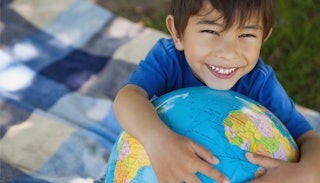How To Teach Your Kids To Be World Citizens

I believe that no matter where or how we live or what we look like, we are all part of one human family. Throughout my childhood, I heard a quote from the Bahá’í Faith — “The earth is but one country, and mankind its citizens” — and have tried to live my life accordingly. While I appreciate and feel grateful for my identity as an American, I have always seen myself as a citizen of the world first. That’s a perspective my husband and I are passing along to our children as well.
Here are some things all parents can do to encourage kids to be world citizens:
Teach them to celebrate differences.
Diversity is what makes life interesting and beautiful. We teach our kids to see differences as positive, as adding flavor and dimension to life, rather than being bad or scary. When kids start noticing differences among people or places or things, get excited and show enthusiasm for their observations. “Isn’t that cool?” or “Wow, neat, let’s learn more about that,” can go a long way to making kids feel comfortable with diverse people and places.
Teach respect for diverse beliefs.
Religion can be a source of conflict, but it doesn’t have to be. There are countless examples around the world of people from different faiths living peacefully, side by side, as friends. A friend with different beliefs is simply a friend with different beliefs. It’s possible to teach your kids your family’s faith and values without disparaging or demonizing others.
Point out connections and commonalities.
While it’s important to teach kids to appreciate diversity, it’s equally important to teach them to find common ground. The vast majority of people share basic human values such as family, friendship, love, and hope. When people start pointing out differences, especially in a negative way, show your kids how to find commonalities.
Explore cultures together.
Every city or town is unique in its demographic makeup, and some places pose more of a challenge in this area than others. If you live in a larger city, seek out opportunities to interact with your hometown’s international population. If you live in a small, not-particularly-diverse town, make use of books and videos to learn more about our family around the world. Listen to music from other countries and in other languages, try out recipes from other cultures, and explore traditional arts from around the globe.
Encourage curiosity and delight in learning about people.
Being a world citizen is really just about loving humanity. When you have a basic, foundational love for your fellow man, you want to get to know them. From a young age, we’ve encouraged our kids to be curious and enjoy learning. We’ve encouraged questions and sought answers together. We’ve tried to serve as examples of being lifelong learners and being genuinely interested in other cultures.
Teach kids to see people’s humanity first, but not to overlook racial or cultural identities.
Every human being is a human being first. But every human being also has a unique identity, which is often influenced by race, ethnicity, and culture. Some feel uncomfortable even acknowledging race, but people’s experiences in the world — which help make up their identity — are impacted by the sociological realities of race, ethnicity, and culture. It’s absolutely okay for your kids to acknowledge those differences, as long as they are learning about those differences from the people whose identities are influenced by them.
Teach them to listen and learn with an open heart and mind.
Part of learning about these differences is learning to listen and learn without judgment or defensiveness. Too many people feel the need to make judgments about anything and everything they see or hear. Teach your kids that it’s possible to listen and learn without automatically categorizing everything as “good” or “bad.” It may be appropriate or necessary to evaluate something that goes against your personal values, but when you’re first being exposed to a different way of thinking or living or eating or whatever, it’s important to keep an open mind.
Travel together.
There is no better way to learn about the beautiful array of people and places on our planet than traveling as a family. Seeing firsthand how different people live, smelling foods being cooked with spices we never use, hearing different languages being spoken all around you, and feeling what it’s like to be an outsider are invaluable experiences. If you can afford to take your kids to another country, do it.
Make service to humanity a priority
Families can find myriad ways of serving others. Ideally, our family strives to help people both locally and internationally. Strengthening our own communities is a vital service, but volunteering with or contributing to global initiatives, especially for those of us from comparably wealthy nations, is also a key component of world citizenship. To avoid getting overwhelmed, choose one issue as a family to focus on — clean water, hunger, etc. — or choose one organization to become involved with.
World citizenship is about celebrating our fascinating world filled with delightfully diverse people and striving to make it a better place. There are many more ways to do that than I listed here, but it’s a start. If we teach our children to see the earth as their home and all people as their family, imagine what an amazing future they can help build for all.